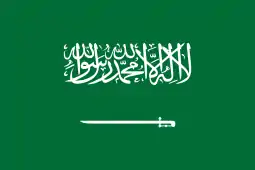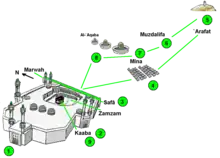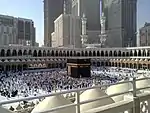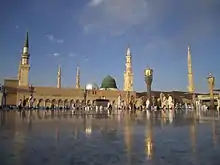Al-Masjid an-Nabawi
Al-Masjid an-Nabawi (Arabic: المسجد النبوي, lit. 'The Prophetic Mosque'), known in English as The Prophet's Mosque, and also known as Al Haram, Al Haram Al Madani and Al Haram Al Nabawi by locals, is a mosque built by the last Islamic prophet Muhammad in the city of Medina in the Al Madinah Province of Saudi Arabia. It was the second mosque built by prophet Muhammad in Medina, after Masjid Quba'a, and is now one of the largest mosques in the world. It is the second holiest site in Islam, after the Masjid al-Haram in Mecca.[2] It is generally open regardless of date or time, and has only been closed to visitors once in modern times, as Ramadan approached during the 2020 COVID-19 pandemic.[3]
| Al-Masjid an-Nabawi المسجد النبوي | |
|---|---|
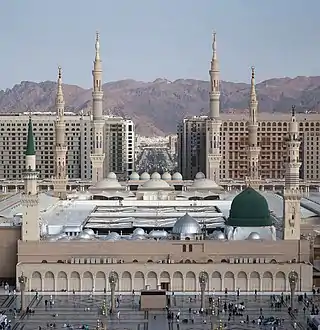  Top: Picture of the mosque from the south with the Green Dome visible to the right. Bottom: A picture of the mosque from the north with the city of Medina in the background. | |
| Religion | |
| Affiliation | Islam |
| Rite | Ziyarah |
| Leadership | Abdur Rahman As-Sudais as President of the Affairs of the Two Holy Mosques Ali Al Hudhaify as Lead Imam of the mosque |
| Location | |
| Location | Al Haram, Medina 42311 |
| Country | Saudi Arabia |
| Administration | The Agency of the General Presidency for the Affairs of the Two Holy Mosques |
| Geographic coordinates | 24.468333°N 39.610833°E |
| Architecture | |
| Type | Religious architecture |
| Style | Mixed Islamic |
| Founder | Muhammad |
| Date established | 623 CE (1 AH) |
| Specifications | |
| Capacity | 1,000,000[1] |
| Minaret(s) | 10 |
| Minaret height | 105 meters (344 ft) |
| Inscriptions | Verses from the Quran and the names of Allah and Muhammad |
| Website | |
| wmn | |
The land of Al-Masjid an-Nabawi belonged to two young orphans, Sahl and Suhayl, and when they came to know that Muhammad wished to acquire their land for the purposes of erecting a mosque, they went to the Prophet and offered the land to him as a gift; the Prophet insisted on paying a price for the land because they were orphaned children. The price agreed upon was paid by Abu Ayyub al-Ansari, who thus became the endower or donor (Arabic: واقِف, romanized: waqif) of Al-Masjid an-Nabawi on behalf of, or in favor of, Muhammad.[4] al-Ansari also accommodated Muhammad upon his arrival at Madinah in 622.
Muhammad shared in the construction of the mosque. Originally an open-air building, the mosque served as a community center, a court of law, and a religious school. There was a raised platform or pulpit (minbar) for the people who taught the Quran and for Muhammad to give the Friday sermon (khutbah). Subsequent Islamic rulers greatly expanded and decorated the mosque, naming its walls, doors and minarets after themselves and their forefathers.
After an expansion during the reign of the Umayyad caliph Al-Walid I, it now incorporates the final resting place of Muhammad and the first two Rashidun caliphs Abu Bakr and Umar.[5] One of the most notable features of the site is the Green Dome in the south-east corner of the mosque,[6] originally Aisha's house,[5] where the tomb of Muhammad is located. Many pilgrims who perform the Hajj also go to Madinah to visit (Ziyarah) the Green Dome. In 1909, under the reign of Ottoman Sultan Abdul Hamid II, it became the first place in the Arabian Peninsula to be provided with electrical lights.[7] The mosque is under the control of the Custodian of the Two Holy Mosques. The mosque is located at the heart of Madinah and is a major pilgrimage site.
History
Construction (622 CE or 1 AH)
The mosque was built by Muhammad in 622 CE (1 AH) after his arrival in Medina.[8] Riding a camel called Qaswa, he arrived at the place where this mosque was built, which was being used as a burial ground.[9] Refusing to accept the land as a gift from the two orphans, Sahl and Suhayl, who owned the land, he bought the land which was paid for by Abu Ayyub al-Ansari and it took seven months to complete the construction of the mosque. It measured 30.5 m × 35.62 m (100.1 ft × 116.9 ft).[9] The roof which was supported by palm trunks was made of beaten clay and palm leaves. It was at a height of 3.60 m (11.8 ft). The three doors of the mosque were the "Gate of Mercy" (باب الرحمة Bab ar-Rahmah) to the south, "Gate of Gabriel" (باب جبريل Bab Jibril) to the west and "Gate of Women" (باب النساء) to the east.[10][9] At this time point in the history of the Mosque, the qiblah wall[11] was facing north to Jerusalem, and al-Suffah was along the northern wall.[12]
First Expansion (628 CE or 7 AH)
After the Battle of Khaybar, the mosque was expanded[13] to 47.32 m (155.2 ft) on each side and three rows of columns were built beside the west wall, which became the place of praying.[14] The mosque remained unaltered during the reign of the first Rashidun caliph Abu Bakr.[14]
Second Expansion by Umar
The second caliph Umar demolished all the houses around the mosque except those of Muhammad's wives to expand it.[15] The new mosque's dimensions became 57.49 m × 66.14 m (188.6 ft × 217.0 ft). Sun-dried mud bricks were used to construct the walls of the enclosure. Besides strewing pebbles on the floor, the roof's height was increased to 5.6 m (18 ft). Umar constructed three more gates for entrance. He also added the "Al Butayha" (البطيحة) for people to recite poetry.[16]
Third Expansion by Uthman (649 CE or 30 AH)
The third caliph Uthman demolished the mosque in 649. Ten months were spent in building the new rectangular shaped mosque whose face was turned towards the Kaaba in Mecca. The new mosque measured 81.40 m × 62.58 m (267.1 ft × 205.3 ft). The number of gates as well as their names remained the same.[17] The enclosure was made of stones laid in mortar. The palm trunk columns were replaced by stone columns which were joined by iron clamps. Teakwood was used in reconstructing the ceiling filza.[18]
Under subsequent Islamic regimes (660-1517 CE or 40-923 AH)

In 707, the Umayyad caliph al-Walid I (r. 705–715) renovated the mosque. It took three years for the work to be completed. Raw materials were procured from the Byzantine Empire.[19] The area of the mosque was increased from the 5,094 square metres (54,830 sq ft) of Uthman's time to 8,672 square metres (93,340 sq ft). A wall was built to segregate the mosque and the houses of the wives of the Prophet. The mosque was reconstructed in a trapezoid shape with the length of the longer side being 101.76 metres (333.9 ft). For the first time, porticoes were built in the mosque connecting the northern part of the structure to the sanctuary. Minarets were also built for the first time as al-Walid constructed four minarets around it.[20]
The Abbasid caliph al-Mahdi (r. 775–785) extended the mosque to the north by 50 metres (160 ft). His name was also inscribed on the walls of the mosque. He also planned to remove six steps to the minbar, but abandoned this idea, fearing damage to the wooden platforms on which they were built.[21] According to an inscription of Ibn Qutaybah, the caliph al-Ma'mun (r. 813–833) did "unspecified work" on the mosque. Al-Mutawakkil (r. 847–861) lined the enclosure of Prophet's tomb with marble.[22] In 1269, the Mamluk Sultan Baibars sent dozens of artisans led by the eunuch emir Jamal al-Din Muhsin al-Salihi to rebuild the sanctuary, including enclosures around the tombs of the Prophet and of Fatima.[23] The Mamluk sultan al-Ashraf Qansuh al-Ghawri (r. 1501–1516) built a dome of stone over his grave in 1476.[24]
First Ottoman period (1517-1805 & 1840-1919 CE or 923-1220 & 1256-1337 AH)

Suleiman the Magnificent (r. 1520-1566) rebuilt the east and west walls of the mosque, and added the northeastern minaret known as Süleymaniyye. He added a new altar called Ahnaf next to the Prophet's altar, Shafi'iyya, and placed a new steel-covered dome on the tomb of the Prophet. Suleiman the Magnificent wrote the names of the Ottoman sultans from Osman Bey to himself (Kanuni) and revived the "Gate of Mercy" (Babürrahme) or the west gate. The pulpit that is used today was built under Murad III (r. 1574-1595).
First Saudi insurgency (1805-1811 CE or 1220-1226 AH)
When Saud bin Abdul-Aziz took Medina in 1805, his followers, the Wahhabis, demolished nearly every tomb and dome in Medina in order to prevent their veneration,[25] except the Green Dome [26] As per the sahih hadiths they considered the veneration of tombs and places thought to possess supernatural powers as an offence against tawhid and an act of shirk.[27] The Prophet Muhammad's tomb was stripped of its gold and jewel ornaments, but the dome was preserved either because of an unsuccessful attempt to demolish its hardened structure, or because some time ago Ibn Abd al-Wahhab, founder of the Wahhabi movement, wrote that he did not wish to see the dome destroyed.[25]
Second Ottoman period (1840-1919 CE or 1256-1337 AH)
In 1817. Mahmud II (r. 1808-1839) completed the construction of the "Purified Residence" (الروضة المطحرة al-Rawdah al-Mutaharah in Arabic and Ravza-i Mutahhara in Turkish) on the southeast side of the mosque and covered with a new dome. The dome was painted green in 1837 and has been known as the "Green Dome" (Kubbe-i Hadra) ever since.[5] Mahmud II's successor, Abdulmecid I (r. 1839–1861), took thirteen years to rebuild the mosque, beginning in 1849.[28] Red stone bricks were used as the main material in reconstruction of the mosque. The floor area of the mosque was increased by 1,293 square metres (13,920 sq ft).
The entire mosque was reorganized except for the tomb of the Prophet, the three altars, the pulpit and the Suleymaniye minaret. On the walls, verses from the Quran were inscribed in Islamic calligraphy. On the northern side of the mosque, a madrasah was built for teaching the Qur'an.[29] An ablution site was added to the north side. The prayer place on the south side was doubled in width, and covered with small domes. The interiors of the domes are decorated with verses from the Qur'an and couplets from the poem "Kaside-i Bürde". The Kible wall was covered with polished tiles with lines from the Qur'an inscribed. The places of prayer and courtyard were paved with marble and red stone. The fifth minaret, Mecidiyye, was built to the west of the surrounded area.
After the "Desert Tiger" Fakhri Pasha's arrest at the end of the Siege of Medina on January 10, 1919, 400 years of Ottoman rule in the region came to an end.
Saudi rule and modern history (1925-present CE or 1344-present AH)
The Saudi takeover was characterized by events similar to those that took place in 1805 when the Prince Mohammed ibn Abdulaziz retook the city on 5 December 1925.[30][31][32][33] After the foundation of the Kingdom of Saudi Arabia in 1932, the mosque underwent several major modifications. In 1951 King Abdulaziz (1932–1953) ordered demolitions around the mosque to make way for new wings to the east and west of the prayer hall, which consisted of concrete columns with pointed arches. Older columns were reinforced with concrete and braced with copper rings at the top. The Suleymaniyya and Mecidiyye minarets were replaced with two minarets in Mamluk revival style. Two additional minarets were erected to the northeast and northwest of the mosque. A library was built along the western wall to house historic Qurans and other religious texts.[29][34]
In 1974, King Faisal added 40,440 square metres (435,000 square feet) to the mosque.[35] The area of the mosque was also expanded during the reign of King Fahd in 1985. Bulldozers were used to demolish buildings around the mosque.[36] In 1992, when it was completed, the mosque took over 160,000 square meters (1.7 million square feet) of space. Escalators and 27 courtyards were among the additions to the mosque.[37] A $6 billion project to increase the area of the mosque was announced in September 2012. After completion, the mosque should accommodate between 1.6 million to 2 million worshippers.[35] In March of the following year, Saudi Gazette reported that demolition work had been mostly complete, including the demolition of ten hotels on the eastern side, in addition to houses and other utilities.[38]
Architecture
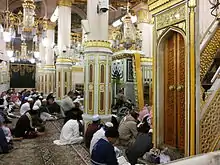
The modern-day Masjid an-Nabawi is situated on a rectangular plot and is two stories tall. The Ottoman prayer hall, which is the oldest part of Masjid an-Nabawi, lies towards the south.[39] It has a flat paved roof topped with 27 sliding domes on square bases.[40] Holes pierced into the base of each dome illuminate the interior when the domes are closed. The sliding roof is closed during the afternoon prayer (Dhuhr) to protect the visitors. When the domes slide out on metal tracks to shade areas of the roof, they create light wells for the prayer hall. At these times, the courtyard of the Ottoman mosque is also shaded with umbrellas affixed to freestanding columns.[41] The roof is accessed by stairs and escalators. The paved area around the mosque is also used for prayer, equipped with umbrella tents.[42] The sliding domes and retractable umbrella-like canopies were designed by the German Muslim architect Mahmoud Bodo Rasch, his firm SL Rasch GmbH, and Buro Happold.[43]

Rawdah ash-Sharifah (The Noble Garden)
The Rawḍah ash-Sharifah (Arabic: روضة الشريفة, lit. 'The Noble Garden') is an area between the minbar and burial chamber of Muhammad. It is regarded as one of the Riyāḍ al-Jannah (Arabic: رِيَاض ٱلْجَنَّة, lit. 'Gardens of Paradise').[44][5][45] A green carpet distinguishes the area from the rest of the mosque, which is covered in a red carpet. Considering visiting Madinah and performing the Ziyarah, Muhammad said:
“Whoever visits me after my death is like he who had visited me during my life.”[46] “When a person stands at my grave reciting blessings on me, I hear it; and whoever calls for blessings on me in any other place, his every need in this world and in the hereafter is fulfilled and on the day of Qiyamah I shall be his witness and intercessor.”[47]
Pilgrims attempt to visit the confines of the area, for there is a tradition that supplications and prayers uttered here are never rejected. Access into the area is not always possible, especially during the Hajj season, as the space can only accommodate a few hundred people and movement is restricted by policemen.[45]
Green Dome
The chamber adjacent to the Rawdah holds the tombs of Prophet Muhammad and two of his companions, father-in-laws and caliphs, Abu Bakr and Umar ibn al-Khattab. A fourth grave is reserved for ‘Īsā (Arabic: عِـيـسَى, Jesus), as Muslims believe that he will return and will be buried at the site. The site is covered by the Green Dome. It was constructed in 1817 CE during the reign of the Ottoman sultan Mahmud II and painted green in 1837 CE.[5]
Mihrab
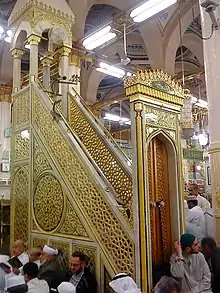
There are two mihrabs or niches indicating the qibla (Arabic: محراب, romanized: mihrab, lit. 'place of war') in the mosque, one was built by Muhammad and another was built by the third Rashidun caliph Uthman. The one built by the latter was larger than that of Muhammad's and acts as the functional mihrab, whereas Muhammad's mihrab is a "commemorative" mihrab.[48] Besides the mihrab, the mosque also has other niches which act as indicators for praying. This includes the Miḥrâb Fâṭimah (Arabic: مِـحْـرَاب فَـاطِـمَـة) or Miḥrāb aṫ-Ṫahajjud (Arabic: مِـحْـرَاب الـتَّـهَـجُّـد), which was built by Muhammad for the Ṫahajjud (late-night) prayer (Arabic: تَـهَـجُّـد).[49]
Minbar
The original minbar (Arabic: مِـنـۢبَـر) used by Muhammad was a block of date palm wood. This was replaced by him with a tamarisk one, which had dimensions of 50 cm × 125 cm (20 in × 49 in). In 629 CE, a three staired ladder was added to it. The first two caliphs, Abu Bakr and Umar, did not use the third step as a sign of respect to the Prophet, but the third caliph Uthman placed a fabric dome over it and the rest of the stairs were covered with ebony. The minbar was replaced by Baybars I in 1395, and later by Shaykh al-Mahmudi in 1417. This was also replaced by a marble one by Qaitbay in the late fifteenth century, which as of 2013, is still used in the mosque.[49]
Minarets
The first minarets (four in number) of 26 feet (7.9 m) high were constructed by Umar. In 1307, a minaret titled Bab al-Salam was added by Muhammad ibn Kalavun which was renovated by Mehmed IV. After the renovation project of 1994, there were ten minarets which were 104 metres (341 ft) high. The minarets' upper, bottom and middle portion are cylindrical, octagonal and square shaped respectively.[49]
Imams and mu'ezzins
| Imams | Name in Arabic |
|---|---|
| Sh. Dr. Ali bin 'Abdurrahman al-Hudhaify | الشيخ الدكتور علي بن عبدالرحمن الحظيفي |
| Sh. Dr. Abdulbari' bin 'Awwad ath-Thubaity | الشيخ الدكتور عبدالرحمن بن عواد الثبيتي |
| Sh. Dr. Hussain bin 'Abdul 'Aziz | الشيخ الدكتور حسين بن عبدالعزيز |
| Sh. Dr. Abdulmohsin bin Muhammad al-Qaasim | الشيخ الدكتور عبدالمحسن بن محمد القاسم |
| Sh. Dr. Salah bin Muhammad al-Budayr | الشيخ الدكتور صلاح بن محمد البدير |
| Sh. Ahmed Taalib Hameed | الشيخ أحمد طالب حميد |
| Sh. Dr. 'Abdullah bin 'Abdurrahman al-Bu'ayjaan | الشيخ الدكتور عبدالله بن عبدالرحمن البعيجان |
| Sh. Dr. Ahmad bin Ali al-Hudhaify | الشيخ الدكتور أحمد بن علي الحظيفي |
| Sh. Dr. Khaalid bin Sulaiman al-Muhanna | الشيخ الدكتور خالد بن سليمان المهنى |
| Imams | Name in Arabic |
|---|---|
| Sh. Abdurrahman Khashoggi | الشيخ عبدالرحمن خاشقجي |
| Sh. Essam Bukhari | الشيخ عسام بخاري |
| Sh. 'Umar Yusuf Kamal | الشيخ عمر يوسف كمال |
| Sh. Sami Dewali | الشيخ سامي ديوالي |
| Sh. Muhammad Majid Hakeem | الشيخ محمد ماجد حكيم |
| Sh. Ashraf 'Afifi | الشيخ أشرف عفيفي |
| Sh. Ahmed 'Afifi | الشيخ أحمد عفيفي |
| Sh. 'Umar Sunbul | الشيخ عمر سنبل |
| Sh. Abdulmajeed as-Surayhi | الشيخ عبدالمجيد الصريحي |
| Sh. Usamah al-Akhdar | الشيخ اسامة الأخضر |
| Sh. Madhi Bari' | الشيخ مهدي بارئ |
| Sh. Anas Sharif | الشيخ أنس شريف |
| Sh. Muhammad Qassas | الشيخ محمد قصاص |
| Sh. Hassan Khashoggi | الشيخ حسان خاشقجي |
| Sh. Ahmed al-Ansari | الشيخ أحمد الأنصاري |
| Sh. Faisal Nu'man | الشيخ فيصل نعمان |
| Sh. Iyadh Shukri | الشيخ عياض شكري |
Gallery
See also
References
- "WMN". Retrieved 26 November 2020.
- Trofimov, Yaroslav (2008), The Siege of Mecca: The 1979 Uprising at Islam's Holiest Shrine, New York, p. 79, ISBN 978-0-307-47290-8
- Farrell, Marwa Rashad, Stephen (2020-04-24). "Islam's holiest sites emptied by coronavirus crisis as Ramadan begins". Reuters. Retrieved 2020-09-12.
- "Masjid-e-Nabwi - IslamicLandmarks.com". IslamicLandmarks.com. 2014-03-29. Retrieved 2020-06-26.
- Ariffin, Syed Ahmad Iskandar Syed (2005). Architectural Conservation in Islam : Case Study of the Prophet's Mosque. Penerbit UTM. pp. 88–89, 109. ISBN 978-983-52-0373-2.
- Petersen, Andrew (2002-03-11). Dictionary of Islamic Architecture. Routledge. p. 183. ISBN 978-0-203-20387-3.
- "The History of Electrical lights in the Arabian Peninsula". Retrieved Jun 15, 2020.
- "The Prophet's Mosque [Al-Masjid An-Nabawi]". Islam Web. Retrieved 17 June 2015.
- Ariffin, p. 49.
- "Gates of Masjid al-Nabawi". Madain Project. Retrieved 18 March 2018.
- "Qibla Wall of Masjid an-Nabawi". Madain Project. Archived from the original on 12 September 2020. Retrieved 12 September 2020.
- "Expansion Chronology of Masjid al-Nabawi". Madain Project. Archived from the original on 12 September 2020. Retrieved 12 September 2020.
- Ariffin, p. 50.
- Ariffin, p. 51.
- Atiqur Rahman (2003). Umar Bin Khattab: The Man of Distinction. Adam Publishers. p. 53. ISBN 978-81-7435-329-0.
- Ariffin, p. 54.
- Ariffin, p. 55.
- Ariffin, p. 56.
- NE McMillan (18 June 2013). Fathers and Sons: The Rise and Fall of Political Dynasty in the Middle East. Palgrave Macmillan. p. 33. ISBN 978-1-137-29789-1.
- Ariffin, p. 62.
- Munt, p. 116.
- Munt, p. 118.
- Marmon, Shaun Elizabeth (1995). "Madina: Sultan and Prophet". Eunuchs and Sacred Boundaries in Islamic Society. Oxford University Press. p. 51. ISBN 978-0-19-507101-6.
- Wahbi Hariri-Rifai, Mokhless Hariri-Rifai (1990). The Heritage of the Kingdom of Saudi Arabia. GDG Exhibits Trust. p. 161. ISBN 978-0-9624483-0-0.
- Mark Weston (2008). Prophets and princes: Saudi Arabia from Muhammad to the present. John Wiley and Sons. pp. 102–103. ISBN 978-0-470-18257-4.
- Doris Behrens-Abouseif; Stephen Vernoit (2006). Islamic art in the 19th century: tradition, innovation, and eclecticism. BRILL. p. 22. ISBN 978-90-04-14442-2.
- Peskes, Esther (2000). "Wahhābiyya". Encyclopaedia of Islam. 11 (2nd ed.). Brill Academic Publishers. pp. 40, 42. ISBN 90-04-12756-9.
- Ariffin, p. 64.
- Ariffin, p. 65.
- "History of the Cemetery Of Jannat Al-Baqi". Al-Islam.org.
- Mark Weston (2008). Prophets and princes: Saudi Arabia from Muhammad to the present. John Wiley and Sons. p. 136. ISBN 978-0-470-18257-4.
- Vincent J. Cornell (2007). Voices of Islam: Voices of the spirit. Greenwood Publishing Group. p. 84. ISBN 978-0-275-98734-3.
- Carl W. Ernst (2004). Following Muhammad: Rethinking Islam in the Contemporary World. Univ of North Carolina Press. pp. 173–174. ISBN 978-0-8078-5577-5.
- "New expansion of Prophet's Mosque ordered by king". Arab News. 30 June 2012. Retrieved 19 June 2015.
- "Prophet's Mosque to accommodate two million worshippers after expansion". Arab News. 26 September 2012. Archived from the original on 7 March 2017. Retrieved 27 November 2016.
- "Expansion of the Prophet's Mosque in Madinah (3 of 8)". King Fahd Abdulaziz. Archived from the original on 4 March 2016. Retrieved 19 June 2015.
- "Expansion of the two Holy Mosques". Saudi Embassy. Archived from the original on 24 September 2015. Retrieved 19 June 2015.
- "Prophet's Mosque to house 1.6m after expansion". Saudi Gazette. Archived from the original on 22 December 2015. Retrieved 19 June 2015.
- "Ottoman Prayer Hall of Masjid an-Nabawi". Madain Project. Archived from the original on 12 September 2020. Retrieved 12 September 2020.
- Frei Otto, Bodo Rasch: Finding Form: Towards an Architecture of the Minimal, 1996, ISBN 3-930698-66-8
- "Archnet". archnet.org.
- MakMax (Taiyo Kogyo Group). "Large scale umbrellas (250 units) completed, covering the pilgrims worldwide with membrane architecture : MakMax". makmax.com. Archived from the original on 2015-10-26. Retrieved 2013-06-10.
- Walker, Derek (1998). The Confidence to Build. p 69: Taylor & Francis. p. 176. ISBN 0-419-24060-8.CS1 maint: location (link)
- Malik ibn Anas. "14.5.11". Muwatta Imam Malik.
- "Islamic Guidelines for Visitors to the Prophet's Mosque". Islam-QA. Archived from the original on 2013-07-09. Retrieved 2011-11-01.
It is prescribed for the one who visits the Prophet's Mosque to pray two rakats in the Rawdah or whatever he wants of supplementary prayers, because it is proven that there is virtue in doing so. It was narrated from Abu Hurayrah that the Prophet said, "The area between my house and my mimbar is one of the gardens of Paradise, and my mimbar is on my cistern (hawd)." Narrated by al-Bukhari, 1196; Muslim, 1391.
- Al-Tabarani, Abu Al-Qasim Sulayman Ibn Ahmad Ibn A. (2013). Al-mu'jam al-awsat. [Place of publication not identified]: Turath For Solutions. ISBN 978-9957-65-703-1. OCLC 927110104.
- Bayhaqi, Abu Bakr Ahmad Ibn Al-Husayn Ibn 'Ali Al- (2013). Sunan al-bayhaqi al-kubra. [Place of publication not identified]: Turath For Solutions. ISBN 978-9957-647-98-8. OCLC 927108750.
- Ariffin, p. 57.
- "The Prophet's Mosque". Last Prophet. Retrieved 19 June 2015.
Notes
Bibliography and further reading
- Fahd, Salem Bahmmam (30 January 2014). Pilgrimage in Islam: A description and explanation of the fifth pillar of Islam. Modern Guide, 2014. ISBN 978-1-78338-174-6.
- Hasrat Muhammad the Prophet of Islam. Adam Publishers. ISBN 978-81-7435-582-9.
- Muhammad, Asad (1954). The Road To Mecca. The Book Foundation, 1954. ISBN 978-0-9927981-0-9.
- Sir, Richard Francis Burton (January 1964). Personal Narrative of a Pilgrimage to Al-Madinah & Meccah, Volume 2. ISBN 978-0-486-21218-0.
External links
| Wikimedia Commons has media related to Al-Masjid an-Nabawi. |
| Wikivoyage has a travel guide for Medina. |
| Wikinews has related news: |


-donatedth_b.jpg.webp)



